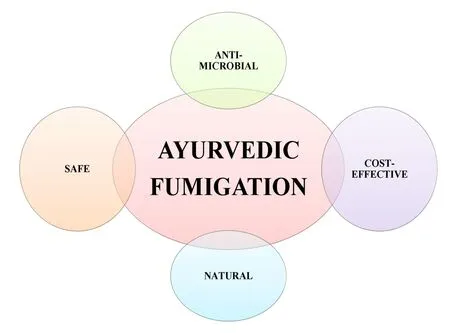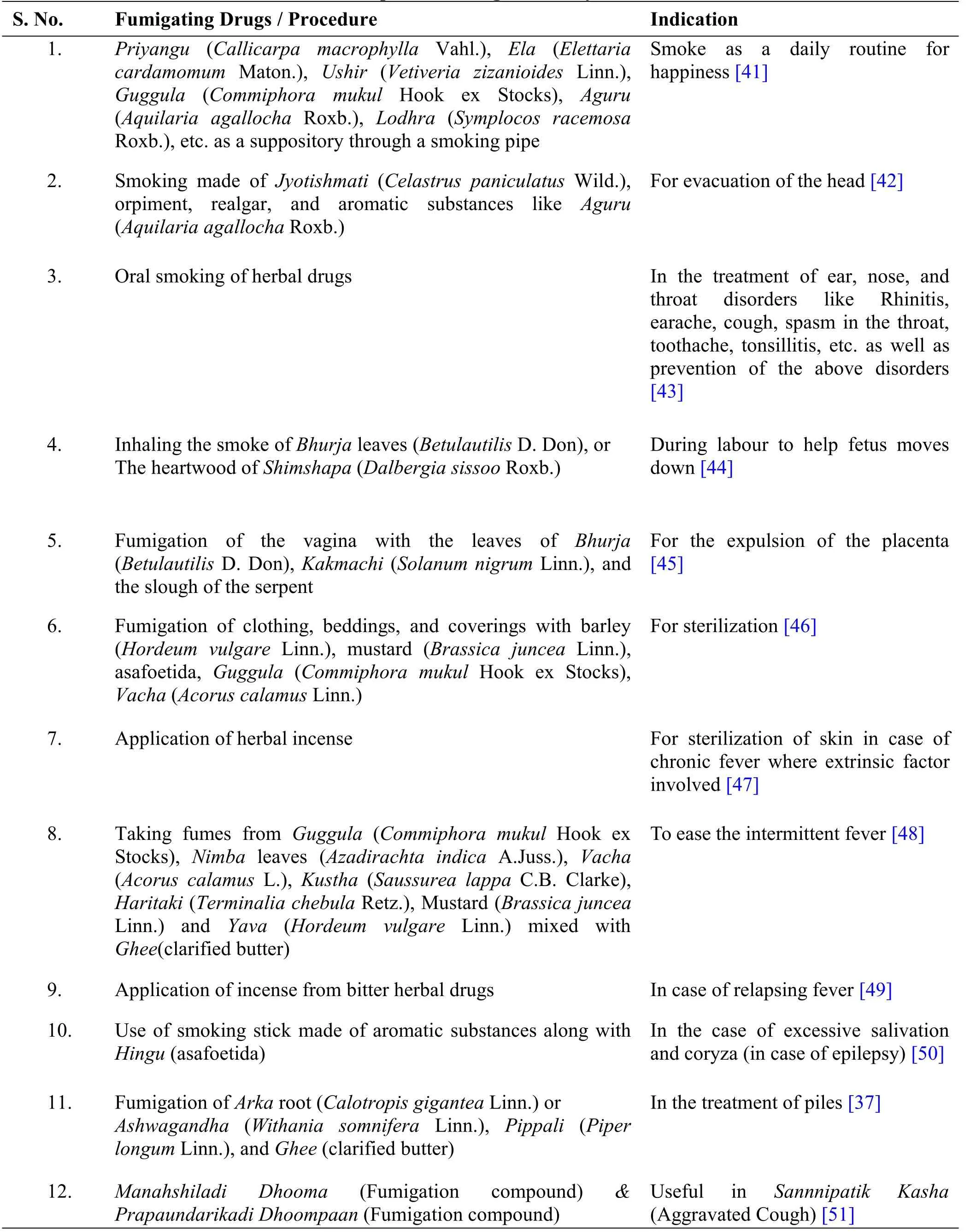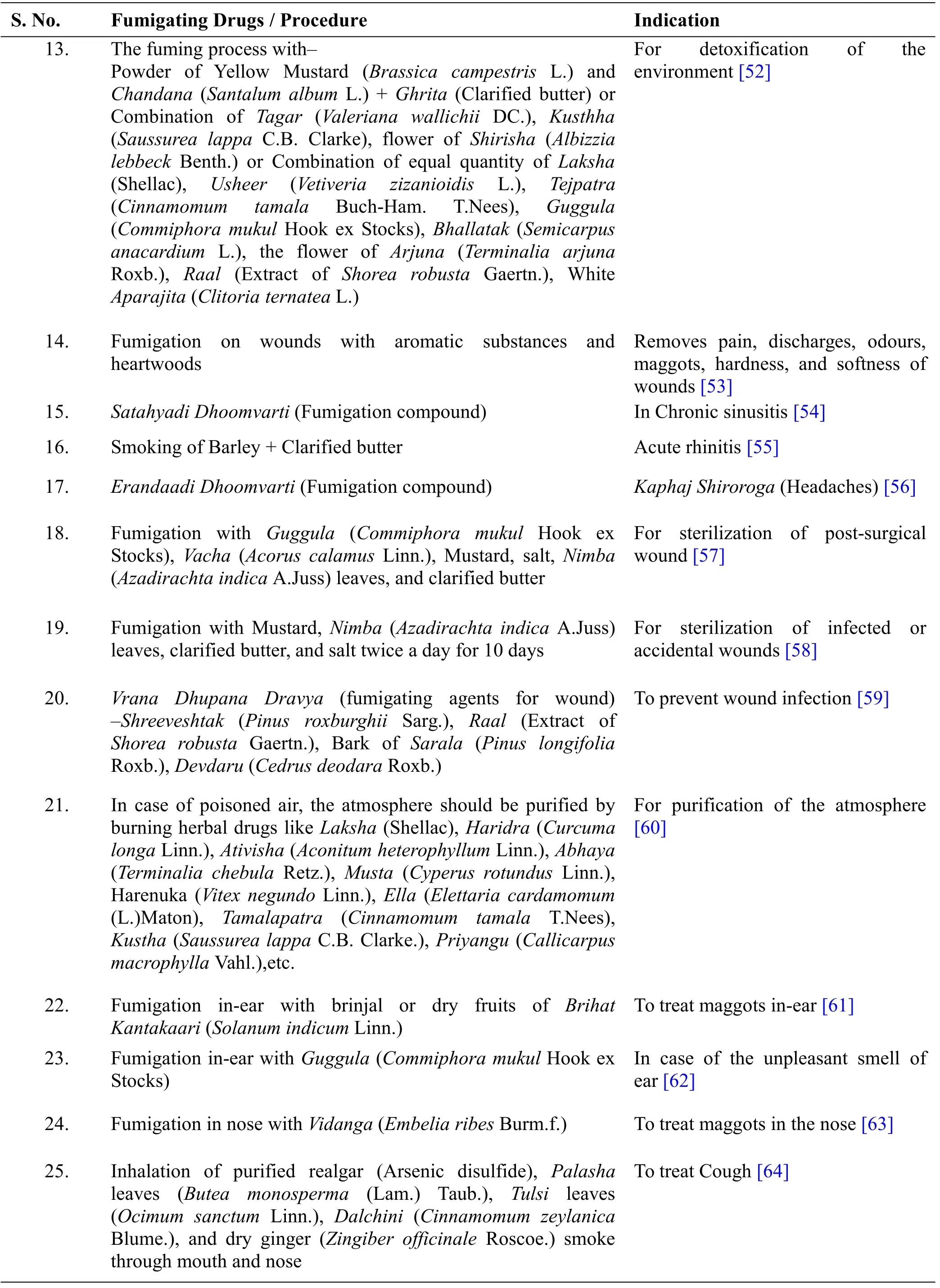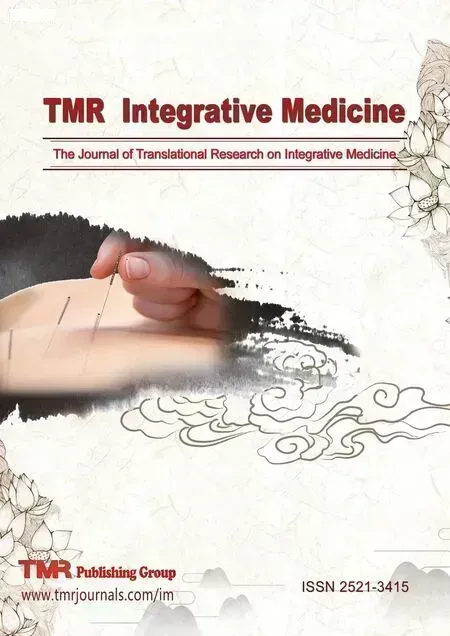Applied aspect of ayurvedic fumigation (Dhupana Karma) in epidemic era:a conceptual review
2022-03-09MohanLalKewatShrikantLnchulkarYuvrajKaushikNagendraSinghChauhanUmakantSahu
Background
Infectious diseases are caused by pathogenic microorganisms, such as bacteria, viruses, parasites, or fungi;the diseases can be spread,directly or indirectly,from one person to another.Zoonotic diseases are infectious diseases of animals that can cause disease when transmitted to humans.
Nearly 50,000 men, women, and children are dying every day from infectious diseases the World Health Organization says in the World Health Report 1996.At least 30 new diseases have emerged in the last 20 years and now together threaten the health of hundreds of millions of people.For many of these diseases,there is no treatment, cure, or vaccine [1].Morbidity because of infectious diseases is very common despite the progress accomplished in recent decades.Every year,the influenza virus circulates widely, infecting from 10% to 40% of the world's population.Based on CDC estimates, there were 59 million infected during the 2009/2010 H1N1 pandemic[2].173,005,553 confirmed cases, 3,727,605 confirmed deaths, and 216 countries or territories affected because of Novel Corona virus disease (COVID-19) pandemic as of 04 June 2021 according to WHO [3].Meanwhile, antibiotics and other life-saving drugs used against many diseases are rapidly losing their effectiveness as bacteria and other microbes develop resistance to them.For example,doctors worldwide are losing some of the most useful and affordable antibiotics against the two principal bacteria which cause pneumonia, the major cause of death in children.
Prevention is always better than cure and the process of disinfection or sterilization is used as a preventive aspect against all the pathogenic microorganisms.The term
is used for all microorganisms in a general perspective and the infectious diseases are known as
under Ayurveda.An epidemic is the rapid spread of disease to many people in a population within a short period, whose detailed description is found in Ayurveda as
[4].Air and land are also among the four factors (Air,Water,Land, and Season)that get contaminated during
, which play a major role in the expansion of an infection.
remedies(fumigation) are being used as
,
etc.since the Vedic period to protect against pathogenic microorganisms.The importance of
in Ayurvedic
is described in various conditions, such as sterilization of operation theatres, labour theatres and also in wound management.
having the literal meaning of fumigation is one of those natural and traditional methods which can be useful in controlling infections.It is the use of medicated fumes.In this race of urbanization and modernity, society has become far from nature and sanitation and closer to microorganisms, giving rise to various diseases.Many substances are used daily to protect against microorganisms,because of their prolonged use,which is harmful to health.In such a situation, we should look for substances originating from nature that are helpful against microorganisms but not harmful to health.So in this way, we aim to show the importance of
(fumigation) against pathogenic microorganisms by reviewing various resources.
Materials related to Ayurvedic fumigation and other relevant topics have been collected from Ayurvedic textbooks, Classical Ayurvedic literatures, various peer-reviewed journals and previous studies conducted on a similar subject at different universities and other research centres.
The concept of previously recorded contagious diseases
JanpadodhwansakarRogas (epidemiological diseases)
means by which mass people get afflicted with disease and destroy the entire region, the disease that spread as epidemics is called "
".This has been described by
in his book
(
chapter 3) in which
(Air),
(Land),
(Season),and
(Water) all are affected [5].As per modern view, we can understand that the above said four factors get vitiated because of pathogenic microorganisms,destroying communities(Epidemics).Airborne diseases are the most common contagious diseases and illnesses spread by tiny pathogens in the air [6].These can be bacteria, fungi, or viruses, but they are all transmitted through airborne contact.Many diseases are spread through the air, such as Corona virus (COVID-19), the common cold, influenza,chickenpox, mumps, measles, whooping cough(Pertussis),tuberculosis.
What a sad man, Diana thought when she first saw him. The future Princess was intrigued3 to finally meet the most eligible4 bachelor in England, thought she was not impressed with his five-foot-ten-inch height, thinking to herself that she would tower over him in high heels. But Diana would later say that she admired his beautiful blue eyes.
Aupsargika Rogas (Communicable or contagious diseases)
4.
(
A.Juss.)-
is also frequently employed as one of the primary constituents in most formulations.Azadirachtin, found in
seed oil,has been shown to have insecticidal effects.In a study,
showed a high level of inhibition to the fumes of
, with a maximum of 90%inhibition in 10 minutes and 50%in 5 minutes[33-35].
Krimi(Pathogenic microorganisms)
Ayurveda is a very practical and ancient science.Ayurveda explains multiple sterilization measures like water purification,
&
(one type of natural fuming procedure by using aromatic and herbal plants),
(Ayurvedic fuming procedure).Ayurveda mainly presents two medical methods of treatment, the first one is
(Medicine)and the second is
(Surgery).Aacharya Sushruta was the one who developed the surgery most in his Sushruta Samhita he has described several
procedures for disinfection of surgical instruments and wounds which can be co-related with Sterilization[10].
The concept of treatment for contagious diseases
Rakshavidhana Karma(Sterilization)
As in contemporary science, there is a separate branch of Helminthology and Microbiology but in Ayurveda,the word
is used for all worms and microbes either it is visible or invisible [9].The word
is derived from D
(Sidhantakaumudi), which means to kill or to yield harmful effects.A range of diseases produced by
is mentioned in Ayurvedic classics such as
(Group of skin disease, Leprosy),
(Tuberculosis),
(diarrhea),
(Anaemia),
(Brain related problems like meningitis,neurocysticercosis)
(Heart diseases).
Modern science also followed this belief and discovered many disinfecting substances and procedures.Sterilization refers to any process that removes, kills, or deactivates all forms of life(referring to microorganisms such as fungi, bacteria,viruses, spores) and other biological agents as prions present in a specific surface,object,or fluid.
5.Materials utilised in the form of
(fumigation), such as
and
, help to promote a healing environment.According to the findings, the Ayurvedic
method has a positive effect on
in the case of bedsores(Prajal Sanjay Jain et al
2021).[36]
Dhupana Karma(Fumigation)
There are millions of micro-organisms around us, in the air, in clothes, etc.The dead cells fallen from the surface of the body carry thousands of such organisms and to our surprise, it contributes almost 37% of our household dust.All these microorganisms are going to give rise to many types of diseases as soon as they get a favorable environment,which can be in the normal to severe category.
is a method by which drugs of herbal, herbs-mineral, or animal origin are used for fumigation to protect against deadly microorganisms[11].There are many combinations and different types of
(Fuming agents) for different microorganisms and purposes which have been stated by different
of Ayurvedic Science.The summary of the Ayurvedic fumigation process is shown in figure 1 and the detailed classification of
materials and actions are mentioned in Table 1.


Quality of.
or
(a group of herbal drugs) destroys the worm by nature.Charaka has specifically described a group of 10 herbal drugs known as
[16].Apart from these, the description of the use of different herbal drugs based on different needs is found in Ayurvedic classics.
Procedure of (fumigation).
The fumigation material should collect during the right season (
) and should be filled in a new earthen pot and placed in a protected place.
is used as
(Powder form) or
(Paste form)as per requirement [17-20].In some references, it has also used as
(Stick like structure)[21,22].
(Instrument for fumigation).
No specific instrument has been described for
but
and
have described
(Pipe like an instrument for fumigation of an infected wound)whose length is 8&10
(fingers)respectively[23,24].
Before they got halfway13 up the hill, the fragrance14 of the lilacs drifted down to them, and the kids started running. Soon, the mother began running, too, until she reached the top.
25. Promised the manikin what he demanded: The young maid seals the bargain with a promise. Promises, while important today, were more powerful in the past when honor was a great motivator. Also, before the time of literacy among the masses and written contracts, verbal promises were given greater weight. A promise was a contract and actionable by law if broken. Folklore emphasizes the importance of a promise by meting punishment upon those who do not keep their promises. The queen is honor bound to keep this promise. Return to place in story.
Description of in Ayurvedic texts.
The utility and importance of
been naturally rendered in various Ayurvedic classic literatures and other modern Ayurvedic texts.It is used for both preventive and therapeutic purposes as well as to gain progeny, fortune, and auspiciousness.The detailed description and more usage of
remedies and substances are seen during the
period.
and
have specifically described it in the separate chapter, which is known as
[25] and
[26] respectively and there are scattered references in other Ayurvedic Samhitas.Based on the recent researches on
and detailed matter mentioned in table 2 about Ayurvedic fumigation (
, the following is a brief description of several herbal medications that have antimicrobial activity:


1.
(
Roxb.)-It has antimicrobial and analgesic effects.
(fumigation) of
is helping in healing wound as well as it suppresses the sensation of pain[27].
2.
(
Hook ex Stocks)-
is found in a variety of
(fumigation) formulas.
volatile oil has been shown to be extremely effective.Gum had a lot of antimicrobial properties against gram-positive bacteria,as well as a moderate level of resistance to gram-negative bacteria[28-30].
3.
(
Linn.
Alpha and beta asarones are primarily responsible for antibacterial action; however, beta asarone has been shown to have higher antimicrobial activity than alpha asarone.Antibacterial activity was discovered in the leaf and rhizome parts of
.
,
,
, and
were all found to be susceptible to the methanolic extract of
[31,32].
What if the old man should die and leave her here alone in the solitary6 cottage deep in the heart of the wood! She would be as terribly lonely as he had formerly7 been
in
describes diseases like
(Group of skin disease),
(Pyrexia or fever),
(Tuberculosis),
(Conjunctivitis),etc are contagious and spreads direct contact with the infected person or by use of contaminated objects.They have spread one person to another through
(close interaction or social gathering),
(physical contact),
(inhalation of expired air or droplets exhalation),
(eating together in one plate or sharing food),
(sleeping together or in groups),
(sitting together or ingroups or using same sitting arrangement) with an infected person and
(sharing clothes, jewels,cosmetics, etc.belongings) of an infected person [7].Modern science also confirms the scientific ness of these views.A contagious disease is a subset category of transmissible diseases, which are transmitted to other persons, either by physical contact with the person suffering the disease or by casual contact with their secretions or objects touched by them or airborne route among other routes[8].
The prince did all as he was told, then they took flight; they crossed the seven seas, and at each one the prince fed the Simurgh When they alighted on the shore of the last sea, it said: O my son! there lies your road; follow it to the city
6.91 percent of post-vaginal delivery with Episiotomy patients reported no discomfort during the first five days of
, as measured by the VAS scale.
(
Burm.f.),
Kurz.),
(
[D.Don] DC.) (2gm each) and
(5gms) are used in
(fumigation)medicine to treat episiotomy wounds for 5 days.In 99.7% of cases, the episiotomy wound healed without infection or sequelae (Anita & Sujata Kadam et al
2020).[37]
Nur Mahomed hid it carefully in his turban, swung himself into the saddle, and five minutes later rode out of the city gates, and set out on his long journey
7.When
,
,
, and
(these are the Ayurvedic fumigation formulations) were fumigated for 20 minutes with
, the mean bacterial colony was significantly different from the control group.
had a 98.94 percent change,
had an 84.13 percent change,
had an 80.51 percent change,and
had a 76.61 percent change(Manita Ahalawat et al
2019).[38]
8.
,
,
,
,
, and other Ayurvedic Dhoopana dravya ingredients.Because of the considerable results of O.T fumigation,it may be used as an insect repellent,room purifier,and air freshner(Anantha kumar V et al
2013).[39]
9.Natural compounds derived from medicinal plants can be used to treat infectious infections in humans(Alam Sher et al.2009).[40]
Every Sunday Jurgen went to church; and when his eyes rested onthe picture of the Virgin Mary over the altar as he sat there, theyoften glided away to the spot where they had knelt side by side
Discussion
At the speed at which we are moving towards modernization and urbanization, at the same pace, we are surrounded by pollution, diseases, and pathogenic microorganisms.Most of the materials & chemicals currently used for disinfection originate from artificial sources and their excessive use is harmful to nature and all creatures.To replace these artificial measures and harmful substances, we must adopt processes and sources that are environmentally friendly.Various natural remedies for disinfection have been described in various texts of Ayurveda,which is one of the oldest medical systems in the world.After evaluating the referenced subjects about
process, their usefulness becomes self-evident, but a detailed action plan and scientific approach are needed to use them in daily life and to establish them as primary disinfection measures.
which is one of these natural remedies, harmonizes with the currently used fumigation process.In this process, medicated fumes using necessary plants are used.
is an important modality&primitive method of sterilization.Several research articles demonstrate it has the property of antimicrobial activity[65,66].Besides,the use of
to treat poisoning has been described in many contexts such as
(24 treatment methods to treat poisoning)[67].Today there are many natural substances used in our daily life that can be used in the process of
, but ignorance is bound to make use of artificial materials in terms of accessibility otherwise.
Conclusion
The antimicrobial activity of
is confirmed based on the topics related to the
process mentioned in Ayurvedic classics and various research articles.It is completely a natural process and much less harmful to the environment than artificial measures.In this epidemic era where our immunity is getting affected day by day, we need to introduce natural, accessible, cost-effective, and most important environment-friendly measures.Therefore, this article shows the importance of the natural
process and to promote their use so that we can play our role in creating pollution and a toxic-free environment.
1.Estimates of food-borne illness, World health organization,https://www.who.int/news/item/01-01-1996-infect ious-diseases-kill-over-17-million-people-a-yearwho-warns-of-global-crisis,Published 1 Jan,1996,Accessed June 8,2021.
2.CDC estimates of food-borne illness in the US,Centres for disease control and prevention,https://www.cdc.gov/foodborneburden/index.html#:~:text=CDC%20estimates%2048%20million%2 0people,known%20pathogens%20and%20unspeci fied%20agents,Accessed June 8,2021.
3.Covid 19 dashboard, World health organization,https://covid19.who.int/,Accessed June 8,2021.
4.Tripathi B.Charaka Samhita: revised by Charaka and Dhridabala with the Charak Chandrika commentary.Varanashi, Uttarpradesh, India:Chaukambha Sanskrit Sansthana;2015:667
5.Tripathi B.Charaka Samhita: revised by Charaka and Dhridabala with the Charak Chandrika commentary.Varanashi, Uttarpradesh, India:Chaukambha Sanskrit Sansthana;2015:668
6.Airborne and direct contact diseases, Maine.gov,https://www.maine.gov/dhhs/mecdc/infectious-dis ease/epi/airborne/index.shtml, Accessed June 8,2021.
7.Shastri A.Sushruta Samhita: Hindi commentary,Varanasi, Uttarpradesh, India: Chaukhambha Surabharti Prakashan;2012:289
8.Contagious disease.Dictionary.com,https://www.dictionary.com/browse/contagious-di sease,Accessed June 8,2021.
9.Tripathi B.Charaka Samhita: revised by Charaka and Dhridabala with the Charak Chandrika commentary.Varanashi, Uttarpradesh, India:Chaukambha Sanskrit Sansthana;2015:711
10.Shastri A.Sushruta Samhita: Hindi commentary,Varanasi, Uttarpradesh, India: Chaukhambha Surabharti Prakashan;2012:179
11.Shastri A.Sushruta Samhita: Hindi commentary,Varanasi, Uttarpradesh, India: Chaukhambha Surabharti Prakashan;2012:24
12.Sharma H.Kashyap Samhita, Varanasi,Uttarpradesh, India.Chaukhambha Surabharti Prakashan;2013:172
13.Sharma Hemraaj, Kashyap Samhita, Varanasi,India.Chaukhambha Surabharti Prakashan;2013:173
14.Tripathi B.Charaka Samhita: revised by Charaka and Dhridabala with the Charak Chandrika commentary.Varanashi, Uttarpradesh, India:Chaukambha Sanskrit Sansthana;2015:118

16.Tripathi B.Charaka Samhita: revised by Charaka and Dhridabala with the Charak Chandrika commentary.Varanashi, Uttarpradesh, India:Chaukambha Sanskrit Sansthana;2015:73
17.Tripathi Bramhanand,Ashtang Hridaya, Varanasi,Uttarpradesh, India: Chaukhambha Publication;2012:905
18.Shastri A.Sushruta Samhita: Hindi commentary,Varanasi, Uttarpradesh, India: Chaukhambha Surabharti Prakashan;2012:25
19.Shrivastava S.Sharangdhra Samhita: Jeevanprada hindi vyakhya.Varanasi, Uttarpradesh, India:Chaukhamba publications;2007:416
20.Tripathi B.Ashtang Hridaya, Varanasi,Uttarpradesh, India: Chaukhambha Publication;2012:943
21.Shastri A.Sushruta Samhita: Hindi commentary,Varanasi, Uttarpradesh, India: Chaukhambha Surabharti Prakashan;2012:176
22.Gupta KA, Ashtang Hridaya, Varanasi,Uttarpradesh, India: Chaukhambha Publication;2007:474
23.Shastri A.Sushruta Samhita: Hindi commentary,Varanasi, Uttarpradesh, India: Chaukhambha Surabharti Prakashan;2012:222
24.Shrivastava S.Sharangdhra Samhita: Jeevanprada hindi vyakhya.Varanasi, Uttarpradesh, India:Chaukhamba publications;2007:415
25.Sharma Hemraaj, Kashyap Samhita, Varanasi,India.Chaukhambha Surabharti Prakashan;2015:255
26.Sharma H.Kashyap Samhita, Varanasi,Uttarpradesh, India.Chaukhambha Surabharti Prakashan;2012:57
27.Tripathi B.Charaka Samhita: revised by Charaka and Dhridabala with the Charak Chandrika commentary.Varanashi, Uttarpradesh, India:Chaukambha Sanskrit Sansthana;2015:118
28.Goyal P, Chauhan A and Kaushik P.Assessment of
(Arn.) Bhandari (
)as potential source for antibacterial agent.
2010;1(3):71-75
29.Ishnava KB, Mahida NY and Mohan JSS.In vitro assessments of antibacterial potential of
(Arn.) Bhandari.gum extract.
2010;2(7):91-96
30.Romero CD, Chopin SF, Buck G, Martinez E,
Antibacterial properties of common herbal 14 Scientifica remedies of the southwest.
2005;99(2):253-257
31.Devi S.A., D.Ganjewala.Antimicrobial activity of
(L.) rhizome and leaf extract,
2009;53(1):45-49
32.Pokharel K, Dhungana B.R., Tiwari K.B.,
.Antibacterial Activities of Some Indigenous Medicinal Plants of Nepal.
2008;30(2):28-32
33.Xie YS, Fields, Isman MB.Repellency and toxicity of Azadirachtin and
concentrates to three stored-product beetles.
,1995;88:1024-1031
34.Rahila N.Studies on Neem(
A.Juss) derivatives as protectants against stored grain insects.2006.Ph.D.thesis, University of Karachi,Karachi.
35.Prabhu N, Renga ramanujam J & Anna Joice P.Efficacy of plant-based holy stick fumigation against infectious bacteria.
,2009;8(2):278-280
36.Jain PS, Chandrakar VS, More MM, Effect of
in management of Bed Sores:A case report.AYUSH: Int.J.Ayu.Teach.Asso.2021;12(1):96-99
37.Anita, Kadam S, Pandey M.EFFECT OF
AND ITS ANTIMICROBIAL ACTIVITY IN STRI ROGA & PRASUTI TANTRA:A REVIEW ARTICLE.
doi:10.46607/iamj4708102020
38.Ahlawat M, Sharma R and Mandal SK.
evaluation of antimicrobial activity of
drugs on
.
2019;10(3):289-292
39.Anantha KV.Study the Efficacy of Ayurvedic
for Operation Theater Sterilization.
.2013;2(1):143-147
40.Sher A.Antimicrobial activity of natural products from medicinal plants.
2009;7(1):72-78
41.Tripathi B.Charaka Samhita: revised by Charaka and Dhridabala with the Charak Chandrika commentary.Varanashi, Uttarpradesh, India:Chaukambha Sanskrit Sansthana;2015:120
42.Tripathi B.Charaka Samhita: revised by Charaka and Dhridabala with the Charak Chandrika commentary.Varanashi, Uttarpradesh, India:Chaukambha Sanskrit Sansthana;2015:120
43.Tripathi B.Charaka Samhita: revised by Charaka and Dhridabala with the Charak Chandrika commentary.Varanashi, Uttarpradesh, India:Chaukambha Sanskrit Sansthana;2015:960
44.Tripathi B.Charaka Samhita: revised by Charaka and Dhridabala with the Charak Chandrika commentary.Varanashi, Uttarpradesh, India:Chaukambha Sanskrit Sansthana;2015:963
45.Tripathi B.Charaka Samhita: revised by Charaka and Dhridabala with the Charak Chandrika commentary.Varanashi, Uttarpradesh, India:Chaukambha Sanskrit Sansthana;2015:980
46.Tripathi B.Charaka Samhita: revised by Charaka and Dhridabala with the Charak Chandrika commentary.Varanashi, Uttarpradesh, India:Chaukambha Sanskrit Sansthana;2015:144
47.Tripathi B.Charaka Samhita: revised by Charaka and Dhridabala with the Charak Chandrika commentary.Varanashi, Uttarpradesh, India:Chaukambha Sanskrit Sansthana;2015:170
48.Tripathi B.Charaka Samhita: revised by Charaka and Dhridabala with the Charak Chandrika commentary.Varanashi, Uttarpradesh, India:Chaukambha Sanskrit Sansthana;2015:175
49.Tripathi B.Charaka Samhita: revised by Charaka and Dhridabala with the Charak Chandrika commentary.Varanashi, Uttarpradesh, India:Chaukambha Sanskrit Sansthana;2015:373
50.Tripathi B.Charaka Samhita: revised by Charaka and Dhridabala with the Charak Chandrika commentary.Varanashi, Uttarpradesh, India:Chaukambha Sanskrit Sansthana;2015:427
51.Tripathi B.Charaka Samhita: revised by Charaka and Dhridabala with the Charak Chandrika commentary.Varanashi, Uttarpradesh, India:Chaukambha Sanskrit Sansthana;2015:540-541
52.Tripathi B.Charaka Samhita: revised by Charaka and Dhridabala with the Charak Chandrika commentary.Varanashi, Uttarpradesh, India:Chaukambha Sanskrit Sansthana;2015:640
53.Tripathi B.Charaka Samhita: revised by Charaka and Dhridabala with the Charak Chandrika commentary.Varanashi, Uttarpradesh, India:Chaukambha Sanskrit Sansthana;2015:714
54.Agnivesh, Charaka Samhita, revised by Charaka and Dhridabala with the Charak Chandrika commentary edited by Bramhanand Tripathi,Varanashi,India.Chaukambha Sanskrit Sansthana;2015:744
55.Tripathi B.Charaka Samhita: revised by Charaka and Dhridabala with the Charak Chandrika commentary.Varanashi, Uttarpradesh, India:Chaukambha Sanskrit Sansthana;2015:744
56.Tripathi B.Charaka Samhita: revised by Charaka and Dhridabala with the Charak Chandrika commentary.Varanashi, Uttarpradesh, India:Chaukambha Sanskrit Sansthana;2015:751
57.Shastri A.Sushruta Samhita: Hindi commentary,Varanasi, Uttarpradesh, India: Chaukhambha Surabharti Prakashan;2012:25
58.Shastri A.Sushruta Samhita: Hindi commentary,Varanasi, Uttarpradesh, India: Chaukhambha Surabharti Prakashan;2012:105
59.Shastri A.Sushruta Samhita: Hindi commentary,Varanasi, Uttarpradesh, India: Chaukhambha Surabharti Prakashan;2012:179
60.Shastri A.Sushruta Samhita: Hindi commentary,Varanasi, Uttarpradesh, India: Chaukhambha Surabharti Prakashan;2012:40
61.Shastri A.Sushruta Samhita: Hindi commentary,Varanasi, Uttarpradesh, India: Chaukhambha Surabharti Prakashan;2012:132
62.Shastri A.Sushruta Samhita: Hindi commentary,Varanasi, Uttarpradesh, India: Chaukhambha Surabharti Prakashan;2012:133
63.Shastri A.Sushruta Samhita: Hindi commentary,Varanasi, Uttarpradesh, India: Chaukhambha Surabharti Prakashan;2012:158
64.Shastri A.Sushruta Samhita: Hindi commentary,Varanasi, Uttarpradesh, India: Chaukhambha Surabharti Prakashan;2012:495
65.Nautiyal CS, Chauhan PS and Nene YL.Medicinal smoke reduces airborne bacteria.
.2007;114(3):446-451
66.Lad N, Palekar S.Preparation and evaluation of Herbal
for cleansing the air.
.2016;4(6):98-103
67.Tripathi B.Charaka Samhita: revised by Charaka and Dhridabala with the Charak Chandrika commentary.Varanashi, Uttarpradesh, India:Chaukambha Sanskrit Sansthana;2015:631
